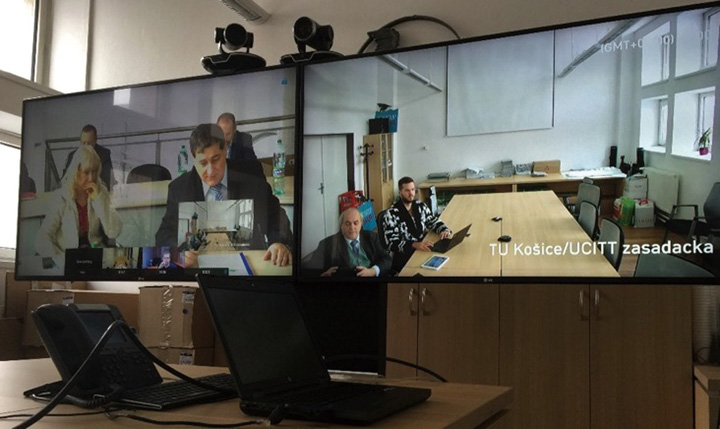CVTI Unveils a New Chapter in Visualized Digital Education
This site uses cookies. By continuing to browse the site you are agreeing to our use of cookies. Read our privacy policy>
![]()
Enterprise products, solutions & services

John Amos Comenius has been hailed as the founder of modern education in Europe, and has laid out the following basic principles: universal education, unified education systems, unified teaching materials, grades, classes, and the abolition of individualized teaching. His famous words — “books are the tools for cultivating wisdom” — truly reflects the human exploration of truth and the acquisition of knowledge during the Age of Enlightenment. As the founder of modern education, the influence of Comenius’ educational philosophy and model is far-reaching, and continues to this day.
Founded in 1919 and named after Comenius, Comenius University adheres to his educational principles and is widely recognized in the international scientific community for its universally acknowledged high-quality teaching. The university is not only the longest-standing and largest comprehensive university in Slovakia, it’s also one of the oldest universities in Europe. This shows that Slovakia has accumulated plenty of expertise in the field of education. In fact, on the whole, Slovakia’s education has grown soundly.
In addition to Comenius University, Bratislava, the capital of Slovakia, is also home to the Slovak Academy of Sciences. Those Slovakian students who have not received higher education through universities can receive education from supplementary and post-secondary education institutions to improve the knowledge and skills needed to qualify for high-value jobs.
Books remain an important cultivator of wisdom in the digital and intelligent worlds. However, books and teaching methods have entered the digital era, and education is set to undergo a transformation. Currently, many countries are promoting the process of education informatization, including teaching processes, teaching and research development, the informatization of resource construction measures, and education experiences — fully entering the digital transformation phase. The Slovak Centre of Scientific and Technical Information (CVTI) has taken the lead in enabling digital transformation in Slovakia.
CVTI is affiliated with Slovakia’s Ministry of Education and is responsible for the construction of ICT infrastructure in the country’s higher education field, covering the education and administrative systems of more than 40 universities. In June 2015, Slovakia’s CVTI Smart Education project officially launched, and was designed to upgrade universities with functions such as remote teaching, High Definition (HD) online classes, and remote conferencing.
Huawei is committed to becoming a global ICT partner in the education industry, bridging the digital divide, enhancing teaching quality, and achieving modern ICT-based education through an impressive array of efficient, flexible, and secure solutions.
The Smart Classroom Solution is now making contributions to basic education in numerous countries such as China, the U.S., Spain, Turkey, South Africa, and Macedonia. In light of this, CVTI chose Huawei to help implement the Smart Education project with the hope of achieving the following goals: quality education resource sharing; excellent performance, remote 1080p HD teaching experiences; and more efficient communications throughout the entire education system — covering universities, laboratories, and administrative organizations.

Huawei’s RP series HD video terminals incorporate high-performance and cost-effective codecs, 12x optical zoom 1080p HD precision cameras, and digital microphone arrays. Combined with full-HD displays and standalone speakers, the RP series terminals are placed on an integrated rack, which results in a single unit with a simple appearance that can be easily relocated. With a compact remote control and touch panel, users can enjoy consistent conference experiences anytime, anywhere.
Huawei’s RP200 high-end video conference terminals can adapt to various remote education scenarios to successfully construct the diversified classrooms required by Slovakia’s education system.
• High-end video conference terminals provide dual-screen displays. Presentation functions are added to traditional videoconferencing to improve teaching scenarios. For example, students located in Martin, Slovakia’s former capital, can participate in off-site discussions and receive real-time teaching from professors in Bratislava.
• Multiple conference rooms can simultaneously connect to share high-quality educational resources and improve efficiency.
• 1080p HD cameras make interactions clearer for a more true-to-life experience. Blackboard notes and instructor facial expressions can be clearly seen by online students during remote lectures, which makes teaching livelier and helps students absorb information with more detail.
• Huawei’s high-end video conference terminals are installed in administrative conference rooms and labs, which reduces travel costs and improves communication and cross-regional scientific experiment efficiency.
Education pioneer John Amos Comenius made the following point roughly 400 years ago: generally speaking, people forced into modern opportunities are busy with the new things they plan to make. However, their wisdom is increasing through various practices, and you could even say it is miraculously increasing day after day. Throughout history, there is not a single point in time when schools could be found in every corner of the world like they are today. Because of this, in the present, everyone is pursuing new things.
In the intelligent era, these ‘new things’ are bound to relate to intelligence and should become the pursuit of education, allowing smart education to enable learning from anywhere at any time. We look forward to Huawei and Slovakia’s CVTI working together to achieve this goal.